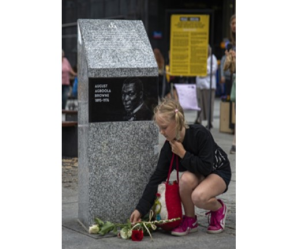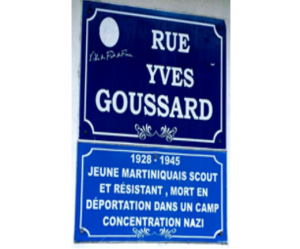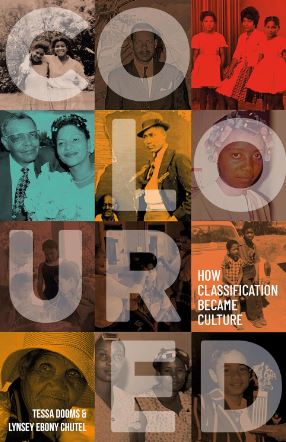Code Word “Courage”: Black Underground Resistance Fighters in Poland, Italy, and France
Written by Robert Fikes, Jr., Emeritus Librarian, San Diego State University
A rather astonishing and unexpected aspect of World War II was the appearance of African and Caribbean-born partisan fighters in Nazi-occupied Europe. White underground resistance fighters, spies, saboteurs, even anti-fascist assassins have been portrayed in movies as romantic, resourceful, ingenious, daring, and courageous, but post-war Hollywood and motion picture studios abroad seemed oblivious to their Black counterparts and were disinclined to allow them such roles on celluloid.
Ask a pundit, historian, or student of popular culture to name a Black resistance fighter in Europe and the person most likely recalled, if any, would be legendary cabaret entertainer Josephine Baker who, among other things, took advantage of her celebrity status and was able to conceal secret messages in her haute couture garments and crashed embassy parties to gather intelligence on German troop movements. She was awarded the Legion of Honour medal and the Croix de Guerre for her wartime service. But there were others: less publicised Blacks who were far more exposed to violence than Baker, who risked capture, torture, and summary execution. They were either very fortunate to have survived or were unlucky in perilous encounters with an enemy infamous for his barbarity.
Had August Agboola Browne not bothered to submit an application to join a veterans’ association in 1949 we probably would be unaware of his journey from Africa to become a hero of the Polish Resistance. Born July 22, 1895, the son of Jozefina and longshoreman Wallace Browne in Lagos, Nigeria, depending on which source is believed he either stowed away on a merchant vessel or accompanied his father to England where he became a member of a theatre troupe that travelled through Germany into Poland in 1922. For reasons known only to him, Browne chose to stay behind in the capital city of Warsaw, the reputed ‘Paris of the North’. For a while he struggled there as a day labourer, but after teaching himself to play drums he eventually became a familiar musician performing in jazz bands in the city’s premier night clubs. In 1928, he earned the distinction of being the first native West African to record a jazz album. Tall, handsome, unfailingly courteous, well dressed, charming and fluent in several languages, as a Polish citizen he married his first wife, Zofyja Pykowna, with whom he had three children. Life was beautiful.
Everything changed on September 1, 1939 when Hitler’s Wehrmacht and accompanying death squads swiftly invaded Poland in what was called a ‘blitzkrieg’ (lightning war). Browne, patriotic to his core, volunteered to fight in the resistance. An estimated 94% of Warsaw’s residents either fled like Browne’s wife and kids who relocated to England, or were killed or wounded. As witnesses later confirmed, he fought alongside his fellow insurgents in the city’s Ochota district, though ultimately theirs was a lost cause. Still, he fought on and remained steadfastly committed to liberating Poland. He avoided being shot distributing underground publications, handled electronic equipment, and assisted escapees from the hell of the Warsaw Ghetto where 91,000 Jews starved to death, were murdered, or died from disease. When the two-month Warsaw Uprising erupted in summer 1944, Browne (code name ‘Ali’) fought in Maj. Georg Antoczewiszka’s 2nd Battalion. It was another failed undertaking (German forces wantonly destroyed 85% of the city and inflicted nearly 200,000 Polish civilian and military casualties).
In the post-war era Browne found work in Communist-controlled Poland as a cultural officer in Warsaw’s Department of Culture and Art, then resumed his career as a musician. The once lively entertainment scene was another casualty of war, so in 1958 he returned to England with his second wife, Olga Miechowicz, playing an occasional gig and living anonymously in northwest London until his death in 1976.
Thankfully, in 2009, a specialist at the Warsaw Rising Museum noticed Browne’s 1949 application to join Towarzystwo Bojowników o Wolność i Demokrację (Society of Fighters for Freedom and Democracy), with a photo attached and a few tantalising handwritten biographical details. Instantly, a long-overlooked hero – and a startlingly Black one to boot – emerged from the document. The facts were presented to conservative President Lech Kaczynski who, perhaps wanting to reassure the world that Poland, one of the least racially diverse nations in Europe, was a model of tolerance and of some diversity, was determined to memorialize Browne’s heroics. After the accidental death of President Kaczynski, the project was taken up by the Fundacja Ruch Wolność i Pokój (Freedom and Peace Movement Foundation) which funded a monument set in Warsaw Central that was unveiled in a ceremony in 2019. Finally, Browne got the tribute he deserved.

Bright, idealistic, and altruistic were qualities that best described the brave young resistance officer Giorgio Marincola. Born in Italian-controlled Somalia in 1923, the same year dictator Mussolini’s Blackshirts were formed, he was the son of Aschiro Hassan, a native woman, and Italian army officer Joseph Marincola, who sent him to the coastal town of Pizzo Calabro, Italy, to be raised by relatives and educated there. A superior student, he studied to become a doctor at the Università di Medicina di Roma. His ambition was to return to Africa to treat victims of tropical diseases. He was profoundly influenced by anti-fascist professor Pilo Albertelli, a founder of the underground anti-fascist Partito d’Azion (Action Party) whose paramilitary wing launched violent guerrilla strikes in 1943 when retreating Germans made Italy a hot war zone.
Weary of political discourse, Marincola veered into armed resistance, putting his medical studies on hold to assist in raids against German military forces in the vicinities of Rome and Viterbo. He received advanced training from the British SOE (Special Operations Executive) and was promoted to Lieutenant. Code name ‘Mercury’, he was wounded in the leg while parachuting on a mission; arrested by the dreaded Nazi SS; and imprisoned at Villa Schneider (Biella). Contemplative and sincere, during his internment he was reported to have said: “I perceive the nation as a culture and a sense of freedom, not as any [racial] colour.”
Marincola was next confined at the Bolzano concentration camp. His enemy captors put him on live radio hoping he would recite a propaganda script critical of the resistance movement. He audaciously did just the opposite, saying: “Homeland means freedom and justice for the peoples of the world. This is why I fight the [German] oppressors.” Immediately, and while still on air, one could hear the sounds of him being beaten. When guards marched off from Bolzano, instead or retiring from the battlefront Marincola rejoined his resistance comrades.
On May 4, 1945, just nine days after Italians had already celebrated Liberation Day and four days before the war in Europe officially ended, vengeful Germans troops set up a checkpoint near an Alpine town to intercept partisans who had recently scored a successful attack against them. Marincola, at age 22, was one of the unfortunate partisans who was shot and killed there that day in what was soon called the Stramentizzo Massacre, as innocent civilians were also murdered. A jarring photo exists that shows his contorted, bullet-riddled corpse snapped just moments following his demise.
The shock and pain of the needless death of a young Black paladin seemed to make it all the more imperative to salute his service. For his supreme sacrifice on behalf of all Italians in 1953 Marincola was awarded the Medaglia d’Oro al Valor Militare, his country’s foremost distinction for valour; in 1964 a street in Chiavazza, Biella, was named for him; and in 2020 a metro station in Rome was dedicated in his honour. These were merited recognitions for an unusual man who had lived an abbreviated but purposeful life.
Once hailed as the ‘Lion of Paris’ and ‘Black Lion of the 17th Arrondissement’, Georges Dukson was easily the most assertive and flamboyant Black fighter in the French Resistance. An acquaintance, journalist René Dunan, recounted details of Dukson’s “magnificent and sad story.” A native of Gabon, then a colony in French West Africa, his father was a military veteran and schoolteacher. Dukson enlisted in the French Army to fight in Europe but was soon among the thousands of POWs captured by German invaders. After two years in captivity in Nazi Germany he somehow managed to escape, find his way to Paris, and lived there in the shadows as a wanted fugitive.
Breaking out of their Normandy beachhead the Allies advanced deeper into France, triggering an uprising in Paris led by the resistance. Dukson was put in charge of a resistance cell in his section of northwest Paris. His aggressive leadership resulted in the disabling of several German trucks and the capture of an enemy tank whose driver he killed. With grenades, Molotov cocktails, and a pistol in hand he trailed behind a commandeered tank hunting down the enemy until he was shot in the arm.
In addition to the newsreel footage of him gleefully posing on that captured tank and a photo of him latched onto a surrendered German soldier, there is footage and still photos of Dukson walking several feet from Charles de Gaulle at the head of a liberation parade on the Champs-Élysées, August 26, 1944. Instead of standing with other rank and file resistance fighters lining the parade route 2nd Lt. Dukson, with his wounded arm in a sling, ignored protocol and impulsively inserted himself beside front row dignitaries. A non-commissioned officer accosted him and forced him to leave at gunpoint.
During his brief time in the limelight admirers paid for his autograph. He was caricatured and toasted to in bars and restaurants. When people sobered from the intoxication of reclaimed freedom and had to face daunting economic realities, Dukson resorted to running a black market operation from an abandoned garage. Later in the year this proved fatal for the former resistance ‘Lion’ who at age 22 was arrested and, on a stopover en route to Mont-Valérien prison, tried to escape and was shot in the thigh. Surgery couldn’t save him. At age 22 he died at Marmottan Hospital. For Dukson there was no medal, monument, or citation
Historian Olivier Wieviorka recently established that Black soldiers in de Gaulle’s Free French army were deliberately kept from marching in de Gaulle’s parade because Allied High Command – particularly its American and British members – asserted “Parisians would be hostile to black fighters” and felt only white faces could inspire confidence in the masses.
Approximately 20,000 French West Africans served in the Free French Army. Nearly 2,200 Sub-Saharan-born Blacks fought in the French Resistance. One of these was Addi Bâ, born Mamadou Hady Bah in French Guinea in 1916, who was reviled by the Nazis who branded him ‘Der schwarze Terrorist’ (‘The Black Terrorist’). In France since 1933, Bâ had travelled there with the family of a white colonial administrator for whom he worked as a cook both in Indre-et-Loire and Paris. Though short in stature, he was allowed to commence military service in the 12th regiment of Senegalese Tirailleurs at the outbreak of war. Taken prisoner in the German onslaught in 1940, he escaped detainment and helped organize the guerrilla resistance group Maquis des Vosges, the first of its kind in eastern France.
Fighting both Germans and the Milice (collaborationist French fascists), Bâ’s prominent position in the Vosges maquis put a large target on his back. His ruse – posing as farm labourer to divert attention from himself – was discerned and he was arrested in November 1943. Rough interrogation and torture preceded his predictable execution on December 18, 1943, at Épinal along with co-founder of the maquis, Marcel Arbuger. Today Bâ is remembered in several film documentaries, books, and streets named in his honour in the Vosges communes of Langeais and Tollaincourt, and the well-received 2017 French movie ‘Nos Patriotes’.
What Yves Goussard had in common with actor Sidney Poitier, writer-poet Edgar Allan Poe, and John Parr, the first British soldier killed in World War I, is that they all lied about their age to enlist in the military. Born in 1928 in Fort-de-France, capital of the French-Caribbean island of Martinique, Goussard’s arrival in France at age 10 was the result of his upper middle-class family wanting to provide the highly intelligent but naturally rebellious and high spirited lad (he was repeatedly expelled from schools) with an opportunity get the best education available in Paris. Active in the Scouts de France (equivalent to the Boys Scouts in the U.S. and U.K.), when German troops overran the northern regions and banned the Scouts Goussard, a 15-year-old student at Notre-Dame du Raincy boarding school, bluffed his way into the Free French forces, Armand-Spiritualist network affiliated with the SOE.
Eight months of training and skirmishes culminated in the August 1944 push to liberate Paris and adjoining areas. In action against the 49th SS Panzerbrigade in the Rougemont pond in Oissery, Goussard, a liaison officer, was shot in the leg. Taken as a POW he was transported to concentration camps in Germany: Neue Bremm transit and torture camp, Oranienbourg-Sachsenhausen north of Berlin, and, in February 1945, notorious Bergen-Belsen in Lower Saxony where inhumane conditions killed 50,000 persons, among them the young Jewish diarist Anne Frank and her sister, Margot. It was at the severely overcrowded Bergen-Belsen that he contracted typhus. Denied proper medical treatment, he died there in the arms of his camp friend sometime in March 1945 at the tender age of 16.
Sadly, Goussard’s mother’s 20-year effort to locate and recover his body was unsuccessful. He was awarded the Cross of Voluntary Resistance Fighter and the Resistance Medal. A street in Fort-de-France also pays homage to him (see photo, left)
Browne, Marincola, Dukson, Bâ, and Goussard all could have quietly sat out the war and waited for others to fight to deliver them from Nazi and homegrown fascist oppression, but passivity and cowardice weren’t central to their character. Pride, gallantry, a taste for danger and adventure, and a strong sense of right and wrong is mainly what drove them, and it was these attributes they harnessed to punish and defeat the enemy. And being foreign born they had one sure way to prove their affection for, and allegiance to their adopted country: defend it to the death. In the afterglow of victory, it was even more apparent that the active presence of the resistance kept the morale of the people they defended from sinking into utter despair, for they knew there were courageous warriors who, acting on their behalf, with stealth, cunning, and speed would strike back at ruthless foreign occupiers and collaborators whenever and wherever an opportunity was presented.




Brown did not fight in Maj. Georg Antoczewiszka 2nd Battalion because such person did not exist, but in Iwo battalion under Maj. Jerzy Antoszewicz. At least you could check the right spelling.
Thank you for this informative blog on the forgotten Black heroes fighting against Nazi_fascism. I am a scholar and I would be curious to have more information and some suggestions on the sources you have consulted on Agboola Browne, Georges Duckson, and Hamadou Ba.